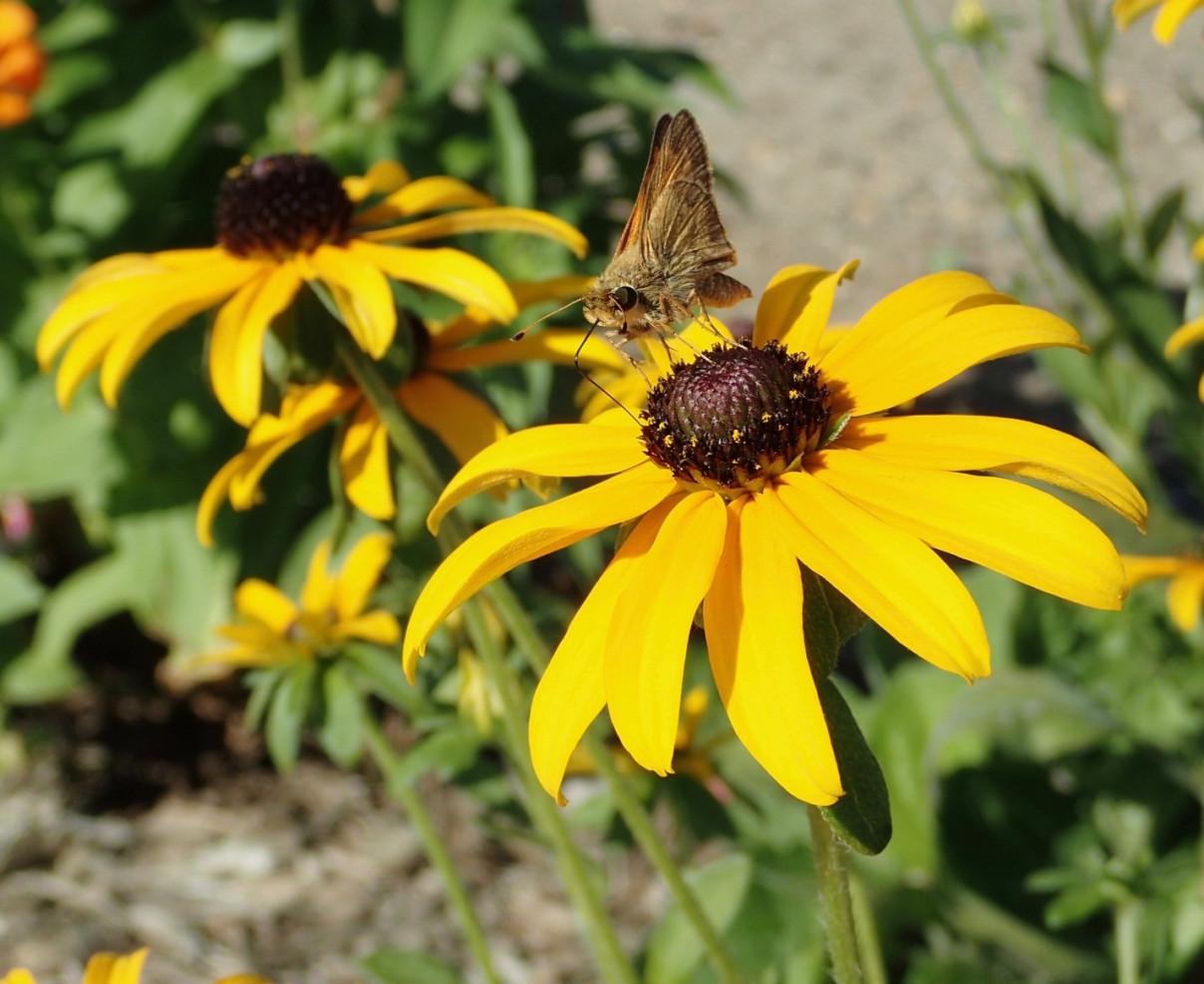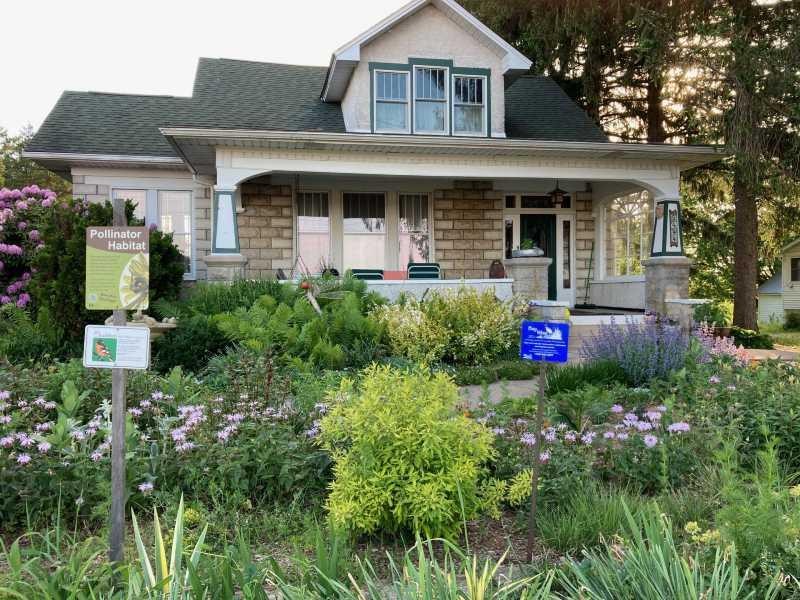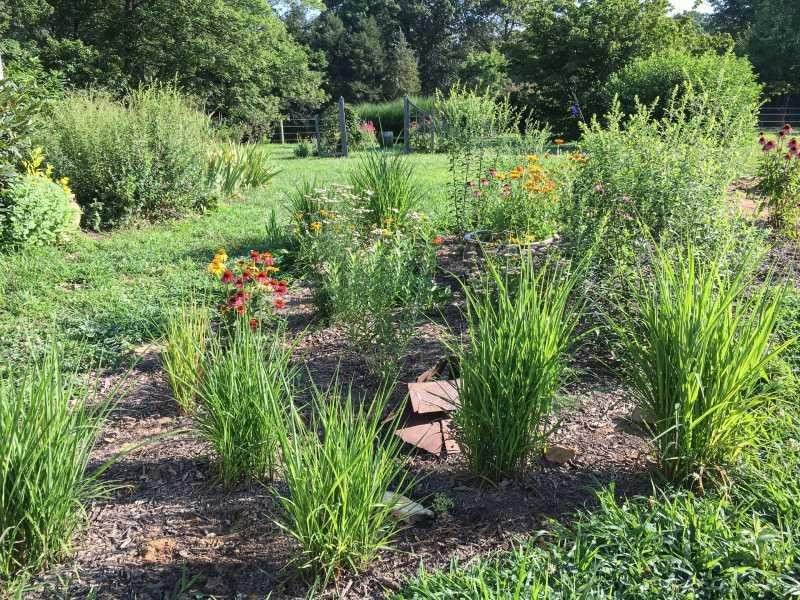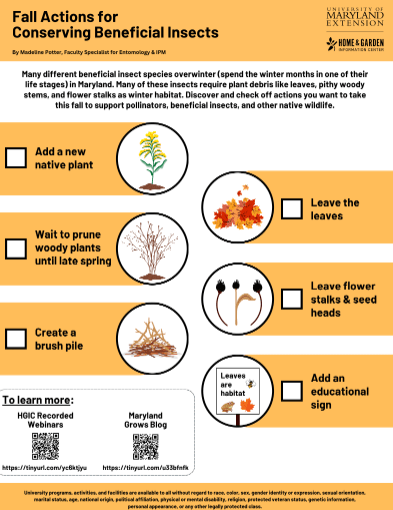
Gardens to support bees, butterflies, and beneficial insects
- Pollinators need what every animal needs: food, shelter, water, and a place to raise a family. Nature usually provides all that pollinators need; we just need to stay out of the way and resist disturbing their natural environment.
- Construct pollinator gardens with a variety of colors, shapes, and heights of plants and include plants that flower throughout the growing season to provide nectar and pollen.
- Eco-region variation in Maryland (mountain, Piedmont plateau, and coastal plain) should be considered when planting pollinator gardens.
- You don’t need a large yard or budget. Even a few plants will help.
- Provide host plants in addition to nectar plants, and habitat for reproduction, life cycle completion, and winter shelter. Some pollinators and beneficial insects need the shelter provided by perennial plants growing in untilled areas, woody plant material such as unused firewood and dead branches, and undisturbed soil in areas that are not mowed or cultivated. See Additional Resources below for lists of host plants.
- Avoid planting invasive species like butterfly bush. There are many alternatives like blazing star (Liatris spicata), New York ironweed (Vernonia noveboracensis), and butterfly weed (Asclepias tuberosa) to plant instead.
- Add a water source in or near the pollinator garden. Consider a dish or birdbath, or even a small pond, and change the water every other day to prevent mosquitoes from breeding.
- Do not use pesticides in your yard or garden. Learn to tolerate some damage and control pests in natural ways.
Pollinators & Climate Change
Planting native species and providing nesting spaces helps to support pollinators that may be migrating into new areas due to climate change.
Plants for Maryland gardens
- Maryland can be divided into three broad physiographic regions, each with unique features such as soil type, climate, precipitation, geology, and topography. The three regions include the (1) western mountains with cooler temperatures and higher average elevations, (2) the rolling hills of the central Piedmont plateau, and (3) the warmer coastal plain.
- There are some plants that are common throughout all three regions, while others are found in only small pockets of the state. The variety of ecosystems in Maryland makes gardening a challenge and a delight!
- Learn more about Maryland's different regions and host plants for Maryland native bees.

Plant native when possible
- We all want to plant native species! There are many benefits to using native plants. Mainly, they are adapted to the environment in which they naturally occur. This means they generally require less tending from gardeners because they are more resistant to regional pests, require less additional watering and fertilizing once established, and in some cases provide the only food source for specialist insects that need specific plant nutrients or products (pollen, nectar, oils) in critical stages of their life cycle.
- Seek out sources of native plants. Though your favorite local nursery may supply some native plants you may want to visit nurseries that specialize in native plants or order them from online sources.
There are several websites to help you find nurseries that provide native plants in your area:
Garden design
Ideally, you want to design your garden with native plants that are specific to the region of Maryland in which you live. Before running to your local nursery, let's examine how to choose the right plants for your unique garden that will attract beneficial natural enemies and pollinators.
- Take note of your garden space and check the sun exposure, soil moisture, and soil type. Pick plants that compliment your yard conditions rather than forcing plants that will not thrive in your yard or container.
- Use the resources below to find plants that will thrive in your region.
- U.S. Fish & Wildlife Service - Native Plants for Wildlife Habitat and Conservation Landscaping: Chesapeake Bay Watershed
- Xerces Society - Pollinator-Friendly Plant Lists
- Pollinator Partnership - Selecting Plants for Pollinators
- Consider how much space you have. Plants best suited for container gardens may differ from those in a large yard. Pollinator container gardens for space-limited living situations also make attractive ornamental container gardens.
Helping pollinators in small green spaces
Designing a garden doesn’t have to be a daunting task! Here are some key factors to consider when you sit down to design your garden space.
- Provide nectar and pollen resources for as long as possible, choose plants that have overlapping periods of bloom. For example, use plants from the daisy or sunflower family (Asteraceae) in a mixture with those of the carrot family (Umbelliferae).
- Design a garden with structural complexity and variety, making sure to be aware of the sun needs of plants. Be cautious not to shade plants that need full sun.
- Different plants attract different pollinators. If you want to target specific pollinators, such as butterflies, try to plant flowers they are attracted to. Butterflies, bees, and hummingbirds are attracted to larger blossoms and tubular-shaped flowers.
- For butterflies, also include host plants that feed young caterpillars. For example, black swallowtail butterfly caterpillars feed on the foliage of native and some non-native plants in the carrot family. Plant some extra carrots, parsley, or dill to share with them!

Pollinator garden design templates for central Maryland
- PDF Sunny and Dry
- PDF Sunny and Moist
- PDF Part Sun and Dry
- PDF Part Sun and Moist
- PDF Shade
- PDF Wet
- PDF Photo Credits for Plant Templates
Pollinator Garden Design Templates, courtesy of Live Green Howard, Howard County Government
Maintenance of a pollinator garden
-
Pollinator gardens are natural places. They are planted to create a habitat for protecting and providing pollinators and beneficial insects with what they need, not just in the summer but all year round.
-
Garden maintenance is different from cultivating a perennial or vegetable garden. Pollinator gardens require less maintenance and perhaps to some can look unkempt. But unpruned perennials and ornamental grasses, leaves, and other garden debris are overwintering places for many of the insects we enjoy seeing in summer.
-
Leave dead plant stalks in the fall and don't prune them back too early in the spring either. Leaf-cutter bees and mason bees nest in the hollow stems of some perennial plants. If you can't wait to prune old stalks, place the clippings in a pile in a less visible section of your garden or yard where stem-nesting bees can make use of them.
-
Download Fall Actions for Conserving Beneficial Insects and check off the actions you want to take in your garden or green space.

-
For more on this topic, read:
-
Waiting on Spring Garden Cleanup to Support Beneficial Insects | Maryland Grows Blog
-
How to Protect Pollinators in the Slow Season | Maryland Grows Blog
-
The Value of a Pile of Sticks in Your Yard or Garden | Maryland Grows Blog
-
(PDF) Nesting and Overwintering Habitat for Pollinators and Other Beneficial Insects | Xerces Society
-
Where do Pollinators Go in Winter? | Xerces Society
-
Additional resources
Managing City and Suburban Yards and Gardens to Sustain Insect Communities | University of Maryland Entomology
What Should I Plant to Help Pollinators | Maryland Grows Blog
(PDF) Keystone Native Plants | National Wildlife Federation
Native Trees: Creating Living Landscape for Birds, Butterflies, Bees, and Other Beneficials | Ohio State University
Neighborly Natural Landscaping in Residential Areas | Penn State Extension
Nesting Resources | Xerces Society
(PDF) Using Native Plants to Attract Butterflies | Maryland Native Plants Society
Margaret Hartman, M.S. student, Department of Entomology, University of Maryland. Rev 9/13/23
Still have a question? Contact us at Ask Extension.
 English
English العربية
العربية Български
Български 简体中文
简体中文 繁體中文
繁體中文 Hrvatski
Hrvatski Čeština
Čeština Dansk
Dansk Nederlands
Nederlands Suomi
Suomi Français
Français Deutsch
Deutsch Ελληνικά
Ελληνικά हिन्दी
हिन्दी Italiano
Italiano 日本語
日本語 한국어
한국어 Norsk bokmål
Norsk bokmål Polski
Polski Português
Português Română
Română Русский
Русский Español
Español Svenska
Svenska Català
Català Filipino
Filipino עִבְרִית
עִבְרִית Bahasa Indonesia
Bahasa Indonesia Latviešu valoda
Latviešu valoda Lietuvių kalba
Lietuvių kalba Српски језик
Српски језик Slovenčina
Slovenčina Slovenščina
Slovenščina Українська
Українська Tiếng Việt
Tiếng Việt Shqip
Shqip Eesti
Eesti Galego
Galego Magyar
Magyar Maltese
Maltese ไทย
ไทย Türkçe
Türkçe فارسی
فارسی Afrikaans
Afrikaans Bahasa Melayu
Bahasa Melayu Kiswahili
Kiswahili Gaeilge
Gaeilge Cymraeg
Cymraeg Беларуская мова
Беларуская мова Íslenska
Íslenska Македонски јазик
Македонски јазик יידיש
יידיש Հայերեն
Հայերեն Azərbaycan dili
Azərbaycan dili Euskara
Euskara ქართული
ქართული Kreyol ayisyen
Kreyol ayisyen اردو
اردو বাংলা
বাংলা Bosanski
Bosanski Cebuano
Cebuano Esperanto
Esperanto ગુજરાતી
ગુજરાતી Harshen Hausa
Harshen Hausa Hmong
Hmong Igbo
Igbo Basa Jawa
Basa Jawa ಕನ್ನಡ
ಕನ್ನಡ ភាសាខ្មែរ
ភាសាខ្មែរ ພາສາລາວ
ພາສາລາວ Latin
Latin Te Reo Māori
Te Reo Māori मराठी
मराठी Монгол
Монгол नेपाली
नेपाली ਪੰਜਾਬੀ
ਪੰਜਾਬੀ Afsoomaali
Afsoomaali தமிழ்
தமிழ் తెలుగు
తెలుగు Yorùbá
Yorùbá Zulu
Zulu ဗမာစာ
ဗမာစာ Chichewa
Chichewa Қазақ тілі
Қазақ тілі Malagasy
Malagasy മലയാളം
മലയാളം සිංහල
සිංහල Sesotho
Sesotho Basa Sunda
Basa Sunda Тоҷикӣ
Тоҷикӣ O‘zbekcha
O‘zbekcha አማርኛ
አማርኛ Corsu
Corsu Ōlelo Hawaiʻi
Ōlelo Hawaiʻi كوردی
كوردی Кыргызча
Кыргызча Lëtzebuergesch
Lëtzebuergesch پښتو
پښتو Samoan
Samoan Gàidhlig
Gàidhlig Shona
Shona سنڌي
سنڌي Frysk
Frysk isiXhosa
isiXhosa